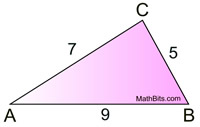|
You are given the lengths of three segments and asked to arrange the segments so that they form a triangle. Will you ALWAYS be able to form a triangle? Or, does the existence of a triangle depend upon the lengths of the given segments?
Consider: Given segments of length a, b and c, draw a triangle with these three segments as its sides.
This example clearly illustrates that there must be some relationship between the lengths of the segments if they are to form a triangle.
In order to draw a triangle, the sum of the lengths of any of the two segments must be greater than the length of the third segment. All THREE possible combinations must be considered and all three must be true for a triangle to exist.
a + b > c
a + c > b
b + c > a |
The problem with the example above is
that a + b is not greater than c. |
Note: The inequalities above are strictly "greater than". If we allowed for them to be "greater than or equal to", the "equal to" portion would create a triangle that is a straight line segment with no area. Such a triangle is called a "degenerate" triangle, and we do not want this to happen.
If a + b = c, still NO triangle.

|
In the diagram at the left, lengths a + b = c.
When trying to form a triangle, you will get 2 straight line segments collapsed on top of one another, but as soon as you move a and b off of c, they start to pull apart from one another, breaking their connection. NO triangle!
|

If you want to form a triangle:
|
The sum of the lengths of any two sides of a triangle must be greater than the third side. |
|
This Theorem is called the "Triangle Inequality Theorem".
 |
If these inequalities are NOT true, you will not have a triangle!
|
|
AB + AC > CB ( 9 + 7 > 5)
AC + CB > AB (7 + 5 > 9)
CB + AB > AC (5 + 9 > 7)
|
|

This next theorem connects the size of a triangle's angle to the length of its opposite side.
|
In a triangle, the longest side is across from the largest angle.
In a triangle, the largest angle is across from the longest side. |
|
Both of these theorems may also be stated using "longer" and " larger" when dealing with 2 sides and 2 angles.
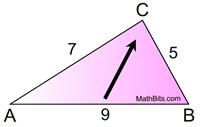
Since 9 is the longest side of the triangle,
∠ C (across from it) is the largest angle. |
|

Since 88º is the largest angle of the triangle,
 (across from it) is the longest side. |
With this understanding that the size of the angle in a triangle affects the length of the opposite side, let's go back to the previous theorem and see how we can find a possible third length of the side of a triangle.
QUESTION: Between what values will the possible lengths for x fall in this triangle?
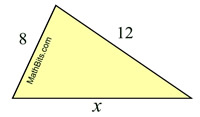 |
Plan of attack: We need to find how "small" x can get but still be a triangle, and also how "large" x can get and still be a triangle.
To make x smaller, the angle between 8 and 12 must get smaller.
To make x larger, the angle between 8 and 12 must get larger. |
Make the angle between 8 and 12 smaller.
As the angle approaches 0º, we approach a degenerate triangle (collapsed).
 If the triangle did collapse onto side 12, there would be a segment of length 4 left on that side (the smallest possible degenerate length). This tells us that x must be greater than 4 to prevent a degenerate (collapsed) triangle.
If the triangle did collapse onto side 12, there would be a segment of length 4 left on that side (the smallest possible degenerate length). This tells us that x must be greater than 4 to prevent a degenerate (collapsed) triangle. |
Make the angle between 8 and 12 larger.
As the angle approaches 180º, we approach another degenerate triangle.
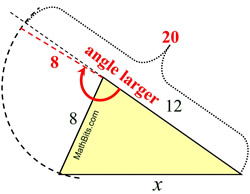 If the triangle did collapse onto the straight line containing side 12, there would be a total segment length of
8 + 12 = 20. This tells us that x must be smaller than 20 to prevent a degenerate triangle.
If the triangle did collapse onto the straight line containing side 12, there would be a total segment length of
8 + 12 = 20. This tells us that x must be smaller than 20 to prevent a degenerate triangle. |
Solution: Side x must have a length greater than 4, but less than 20 to establish a triangle.
4 < x < 20
 |
Did you see a "pattern" from these observations as to how you can quickly find the limitations on the length of the third side of a triangle?
4 < x < 20
(12 - 8) < x < (12 + 8)
(subtract lengths of other 2 sides) < x < (add lengths of other two sides)
|
|

1.
|
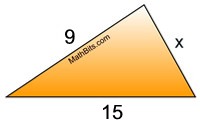 Given the 2 sides shown,
Given the 2 sides shown,
find the "possible" lengths
of the third side. |
Solution: Using the theorem:
• 9 + x > 15 so x > 6
• x + 15 > 9, so x > -6 (no info, length positive)
• 9 + 15 > x, so 24 > x
Putting the statements together, we have x must be greater than 6, but less than 24.
6 < x < 24
Also: (15 - 9) < x < (15 + 9) |
|
2.
|
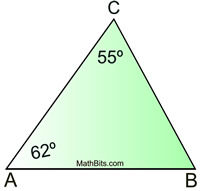 Given the 2 angles shown,
Given the 2 angles shown,
determine which side is the
"longest" side of the triangle. |
Solution:
We must find m∠B to determine if it is larger than 62º, making it the largest angle in the triangle.
m∠A + m∠B + m∠C = 180º
62º + m∠B + 55º = 180º
m∠B = 63º, making ∠B the largest angle in the triangle.
 is the longest side is the longest side.
|
|

NOTE: The re-posting of materials (in part or whole) from this site to the Internet
is copyright violation
and is not considered "fair use" for educators. Please read the "Terms of Use". |
|




